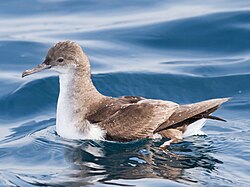Breeding
Surprisingly, very little is known about the breeding biology and phenology of fluttering shearwaters. However, it is known that fluttering shearwaters, like most birds, are monogamous in that they breed with one mate throughout their life. Fluttering shearwaters start to breed when 4–10 years old and the breeding season runs from August to January. They nest in burrows and the nest chamber is made of dead leaves, grass, feathers and shoots. Their burrows are comparatively shallow and they usually built burrows in fragile soils, so if people move around their breeding areas, burrows are easily destroyed. To protect them, access should be strictly restricted. [6]
Like all birds, fluttering shearwaters breed via a process known as true oviparity. With both sexes containing their own sexual reproductive systems and once a female and a male are ready to mate, their reproductive organs, ovaries and testes, begin to swell and produce the ova and sperm, respectively. [11] The male then inseminates the female which fertilises the ova, resulting in a fertilised egg. [12] A singular egg then hatches external to that of the mother. [13]
Some birds stay at colonies throughout the year but most birds fly to colonies in August to woo and sweep burrows for breeding. After mating, females leave colonies for one to six weeks for forming eggs. Males also leave but return to nest sites a few times. Eggs are laid from early September and to mid-October. Usually they lay one white eggs in a burrow or occasionally in crevices and holes among the rock. Sometimes there are two eggs in one nest because two females share a site. [14]
Males and females incubate eggs together and eggs hatch in November. [14] The mean incubation length, nestling period as well as independent age are unknown. [6] Young birds are frequently fed daily by their parents by incomplete ruminate and chicks leave their colonies at night. [9] Fluttering shearwater chicks stay in their burrows and 'wing exercise' in the weeks before fledging. [15] Once they have flown, they are totally independent of their parents. [14]
The breeding success observed on Burgess Island is 63.8%, with 73.3% of hatching success and 88.2% of hatched chicks survival, egg loss and competition with other birds are the main reasons. [15] Chicks are easily attacked because parents usually leave baby birds alone after hatching, only returning to burrows to feed them after long intervals. Many young or old birds may dead on land when they meet bad weather and lack food. [9] Fluttering shearwaters are members of the family Procellariidae, which are characteristically long-lived. The lifespans of several species are over 25 years. [14]
Moulting
Moulting behaviour is divided into two types – adult post-breeding and post-juvenile. [9] For adults, promptly after the breeding season comes to an end, they begin to moult by discarding older, rundown feathers to make way for the newer, unblemished feathers. This process takes place between late summer up until autumn. The date of moulting for immature birds in South Australia is four to five months ahead of the adults in New Zealand. Feathers in body start to moult in October while feathers in wings is early November. In New Zealand, birds have not yet been recorded moulting that start in October or November, maybe young birds are not appear in areas that near the shore for the first year of life. [7]




